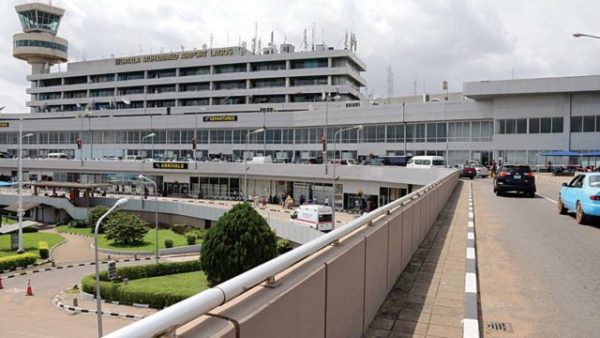
Airport, also called air terminal, aerodrome, or airfield, site and installation for the takeoff and landing of aircraft. An airport usually has paved runways and maintenance facilities and serves as a terminal for passengers and cargo.
The vast majority of airfields throughout the world are still relatively simple facilities. Even now, many have unpaved runways or at most lightly paved runways with tiny terminal or administration buildings, a rudimentary control tower, and crude landing aids. Such facilities can deal only with light aircraft and a negligible flow of passengers or freight. Heavy air traffic, on the other hand, is now almost entirely handled by sophisticated airport facilities that can accommodate the needs of crew, passengers, and freight and the great range of aircraft types that have evolved to meet the needs of modern air transport and general aviation.

More than 100 airports around the world now handle at least 10 million passengers each per year; nearly half of these are in the United States. Dozens of airports regularly move more than 30 million passengers on a yearly basis, and almost a dozen, ranging from the Hartsfield Atlanta International Airport in the U.S. state of Georgia to London Heathrow Airport in the United Kingdom to Beijing Capital International Airport in China, each handle more than 50 million. The Memphis (Tennessee) International Airport, the home airport of the FedEx Corporation’s cargo service, and the Hong Kong International Airport are the world’s largest cargo shippers, each of which handled nearly four million tons in 2007. In order to meet the increasing demand for air travel, large transport aircraft powered by multiple jet and turboprop engines have been built. Such aircraft require extensive ground facilities, runways, taxiways, fire-fighting and rescue services, passenger- and cargo-handling facilities, access to car parking and public transport, lighting, navigational and approach aids, and various support facilities such as catering, meteorology, and governmental inspection. In order to be attractively convenient, the complex of activities and facilities that make up a modern airport must be located sufficiently close to the main centres of world population. At the same time, they must be adequately distant, so that the environmental problems associated with the noise of large aircraft and the activities of large numbers of passengers, workers, and visitors do not become intolerable to the cities that are served.
The largest airports in the world employ more than 100,000 workers each. They are immensely complex entities with regard to the physical facilities that they comprise, the organizations that are active within their boundaries, and the services that are provided in conjunction with their operation.

Physical facilities include runways, taxiways, aprons, and strips, which are used for the landing and takeoff of aircraft, for the maneuvering and positioning of aircraft on the ground, and for the parking of aircraft in order to load and discharge passengers and cargo. For the safe landing and takeoff of aircraft, lighting and radio navigational aids are provided. These are supplemented by airfield markings, signs and signals, and air traffic control facilities. Support facilities on the airside of the field include meteorology, fire and rescue, power and other utilities, aircraft maintenance, and airport maintenance. Landside facilities are the passenger and cargo terminals and the access system, which includes parking, roads, public transport facilities, and loading and unloading areas.

Many organizations are involved in the operation of a modern airport. Overall management is usually in the control of an organization, authority, or company that holds a license to operate the facility. This license is granted subject to a judgment by the national civil aviation authorities that the managing body is fit and competent to run an airport within national and, if applicable, international laws governing safety and operations. While overall responsibility for efficient, safe, and legal operation lies with the airport management, many of the individual services at an airport are provided by other organizations. Such organizations include airlines; air traffic control authorities; ground handling companies; fixed-base operators; concessionaires; security organizations; governmental agencies responsible for customs, immigration, health control, and police; support companies providing flight catering, fueling, aircraft engineering, and maintenance; aero clubs; and flying schools. Since the early 1980s, when privatization began to sweep through civil aviation, terminal-operation companies have also become more frequent, such as those that own terminals in Birmingham, Eng.; Brussels; and Toronto.
Airport services related to the aircraft are frequently referred to as airside. Many of these services are concentrated on the apron, or ramp, which is that part of the operational surface adjacent to the terminals where aircraft are maneuvered or parked. They include the apron handling of aircraft, airside passenger transfer to the aircraft, the handling of baggage and cargo, aircraft fueling, catering and cabin cleaning, engine starting, deicing, ground power and air-conditioning, and minor maintenance engineering. Other airside services are runway inspection, lighting and navigational aids, fire fighting and rescue, airside maintenance, and air traffic control. Among the landside services are those related to ground passenger handling; these include check-in, security, customs and immigration, baggage delivery, information, catering, cleaning and maintenance, shops and concessionary facilities, automobile rental, ground transportation, porters, special help for the elderly and handicapped, automobile parking, and public transportation (including taxis). In addition, because airports employ such a large number of workers, extensive provision must be made for their daily requirements.
Site selection
Aeronautical and environmental factors
Selecting a site for a new airport, or evaluating how well an existing site can be expanded to provide a new major airport, is a complex process. A balance must be achieved between aeronautical and air-transport requirements and the impact of the airport on its environment.
From an aeronautical viewpoint, the basic requirement of an airport is that it have a relatively flat area of land sufficiently large to accommodate the runways and other facilities and that this area be in a locality free from such obstructions to air navigation as mountains and tall buildings.
From the viewpoint of air-transport needs, airport sites must be sufficiently close to population centres that they are considered reasonably accessible to their users. Environmental considerations, on the other hand, dictate that the site should be far enough away from urban centres that noise and other deleterious effects on the population should be kept to acceptable levels. Furthermore, the airport should not destroy areas of natural beauty or other significance. These two sets of requirements, the aeronautical and the environmental, almost inevitably clash, with the conflict becoming more severe as the scale of the envisaged airport increases.
The most modest airport facility—with a single runway, an apron, and a building that serves simultaneously as terminal, administration area, and control tower—can comfortably be built on a site as small as 75 acres, since it requires only a flat, well-drained area sufficient to accommodate a short runway and its surrounding safety strip. Larger and more modern airport facilities, on the other hand, require multiple runways of extended length, extensive terminal apron areas, and large expanses of land devoted to parking and landside access roads. For such an airport, a minimum area of 3,000 acres is likely to be required. Several major airports—such as Dallas–Fort Worth International Airport in Texas, King Abdul Aziz International Airport near Jiddah, Saudi Arabia, and Charles de Gaulle Airport near Paris—are built on sites well in excess of this figure.
The selection process
The site-selection process for large airports can take many months; in some notable cases it has extended over many years. The procedure is complicated by the number of factors that must be taken into account. First, the operational capability of the site is assessed, particularly with respect to weather conditions such as wind, snow, ice, fog, and low visibility and also with respect to obstructions to air navigation around the airport, particularly on the approach and takeoff paths. The location of the facility in relation to air-traffic-controlled airspace is also operationally important. In addition, there must be an evaluation of the capacity of the available land to accommodate the expected configuration of runways and other facilities. Flat or very gently undulating land is necessary, because runways must be constructed according to restrictions on maximum allowable slopes—which in turn are governed by aircraft performance on landing and takeoff.
Ground access to the airport is also considered. An evaluation is made of the distance from population centres, the regional highway infrastructure, public transport facilities (including railways), and the availability of land for parking. Development costs are also estimated, taking into account the nature of the terrain, soil and rock conditions, drainage requirements, and local land values.
The environmental consequences of an airport development rank very high in any site-selection procedure. The impact of aircraft noise on the neighbouring population is often the most significant environmental factor, but, in many countries, account must also be taken of the impact on the flora and fauna of the area, pollution through chemical runoff into local groundwater, the presence of endangered species or significant cultural sites, and even undesirable changes in land use. Many governments now require that environmental analyses of airport development projects include evaluations of population relocation, changes in employment patterns, and distortion of existing regional land use and transportation planning.
Airfield layout and configuration
Operational requirements
It is obvious even to the most casual observer that there is a large variation in the appearance and layout of airport facilities. Simple airports designed to accommodate light aircraft are essentially similar, but, as airports become larger and more complex, thus accommodating more passengers and cargo, their individual requirements affect their layouts and ensure that each becomes recognizably different.
The principal determinants of airport layout are the number of runways and their orientation, the shape of the available site, and constraints at the site both on the ground and in the air. The location and orientation of runways is governed in turn by the need to avoid obstacles, particularly during landing and takeoff procedures. For the largest airports, obstacles to air navigation must be considered up to about 15 km (10 miles) from the runways. Runway configurations must also ensure that, for 95 percent of the time, aircraft can approach and take off without either crosswinds or tailwinds that would inhibit operations. At the smallest airports, light aircraft are unable to operate in crosswinds greater than 10 knots; at all airports, operation in tailwinds in excess of 10 knots is not recommended by aircraft manufacturers (10 knots, or nautical miles per hour, is equal to about 12 statute miles per hour or 19 km per hour).
Runway configurations
The operational capacity of an airport, which is usually defined as the maximum possible number of aircraft landings and takeoffs, is determined by the number of runways that are available for use at any one time. The vast majority of airports around the world have the simplest possible layout, a single runway. Where crosswinds would be high for an unacceptable proportion of operational time, a two-runway configuration is necessary, usually in the form of a main runway and an auxiliary crosswind runway. Depending on the shape of the site and the availability of land, the crosswind facility can take on a crossed configuration or an open or closed V layout. Where visibility is good and aircraft can operate under visual flight rules (VFR), operational capacity increases from the lowest level, crossed runways, through the closed V and open V configurations. However, in poor visibility or under certain conditions of very heavy air traffic, aircraft must operate under the strict instructions and rules of air traffic control and instrument operation; these are called instrument flight rules (IFR). Under such conditions, crosswind runways cannot be used simultaneously with main runways, so that the capacities of the crossed and V configurations are equivalent to that of a single runway.
An increase in operational capacity under VFR is possible with the use of a close parallel runway configuration. Most very large airports must be assured of adequate capacity even under IFR conditions, and this can be achieved by separating the parallel runways by a minimum of 1,035 metres (3,400 feet), which was the distance approved by the International Civil Aviation Organization on Nov. 9, 1995. This independent parallel configuration permits simultaneous independent landings and takeoffs on both runways. Munich Airport exemplifies this type of configuration. Even greater capacity is possible using a four-runway configuration of independent close parallels, as is the case at Los Angeles International Airport. With such a configuration, even under IFR, it is possible for two aircraft to land simultaneously while two other aircraft take off. A number of the world’s largest airports have master plans that feature eight runways in the form of independent close parallels supplemented by other close parallels that are capable of crosswind operation. However, with passenger aircraft increasing in size, most can now operate in crosswinds of 20 knots and above. This reduces the likelihood that configurations with four crosswind runways will ever be constructed.
Runway pavements
Until the introduction of heavy monoplane aircraft in the latter part of the 1930s, civil air-transport aircraft were able to operate from grass runways with takeoff distances of less than 600 metres (2,000 feet). The advent of heavy aircraft such as the DC-3 required the provision of paved runways; at the same time, takeoff distances increased to more than 900 metres (3,000 feet). The length requirements for runways continued to increase into the mid-1970s, when large civilian aircraft such as the Douglas DC-8 and some models of the Boeing 747 required almost 3,600 metres (12,000 feet) of runway at sea level. (Even longer runways were necessary at higher elevations or where high ambient air temperatures occurred during operations.) The trend toward increasing runway lengths caused many problems at existing civilian airports, where runways had to be extended in order to accommodate the new aircraft. Ultimately, pressure by airport operators and the development of turbofan jet engines arrested and finally reversed the trend. Since the 1970s, runway length requirements have actually decreased, and the takeoff and climb performance of civilian aircraft has improved substantially. This has brought a dual benefit in reducing the area of land required by an airport and also in reducing the area around the airport that is adversely affected by noise on takeoff.
In most countries airports may be privately, municipally, or nationally owned and operated, and the siting of an airport may be subject…
At all but the smallest airports, pavements are now provided for runways, taxiways, aprons, and any other areas where aircraft are maneuvered. Pavements must be designed in such a way that they can bear the loads imposed by aircraft without failure. A pavement must be smooth and stable under conditions of loading during its expected or economic life. It should be free from dust and other particles that could be blown up and ingested into engines, and it must be capable of spreading and transmitting an aircraft’s weight to the existing subsoil (or subgrade) in a manner that precludes subsoil failure. Another function of the pavement is to prevent weakening of the subsoil by moisture intrusion, especially from rainfall and frost.
Airfield pavements are of two types, rigid and flexible. Rigid pavements are constructed of portland cement concrete slabs resting on a prepared subbase of granular material or directly on a granular subgrade. Load is transmitted through the slabs to the underlying subgrade by flexure of the slabs. Flexible pavements are constructed of several thicknesses of asphalt or bituminous concrete layers overlying a base of granular material on a prepared subgrade. They spread the concentrated aircraft wheel loads throughout their depth until the load at the base of the pavement is less than the strength of the in situ soil. At all depths the strength of the pavement should be at least equal to the loads placed upon it by aircraft wheels. The choice of pavement type is often determined by economics. In some parts of the world, portland cement concrete is cheaper than asphalt; in other parts, the converse is true. For certain parts of the airfield, however, asphaltic concrete is an unsuitable material for pavement construction because of its vulnerability to damage by aviation fuel. Therefore, even at airports where flexible airfield pavements are generally in use, it is usual for concrete pavements to be used where aircraft stand on the aprons and at runway ends where fuel spillage is frequent.
Culled from Encyclopedia Britannica
 MMS PLUS NG – Maritime, Aviation, Business, Oil and Gas News Online Newspaper with coverage in Maritime, Oil and Gas, Aviation, Power and Energy as well as Financial News
MMS PLUS NG – Maritime, Aviation, Business, Oil and Gas News Online Newspaper with coverage in Maritime, Oil and Gas, Aviation, Power and Energy as well as Financial News









